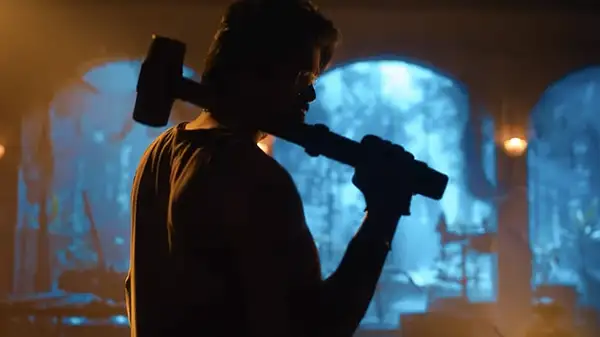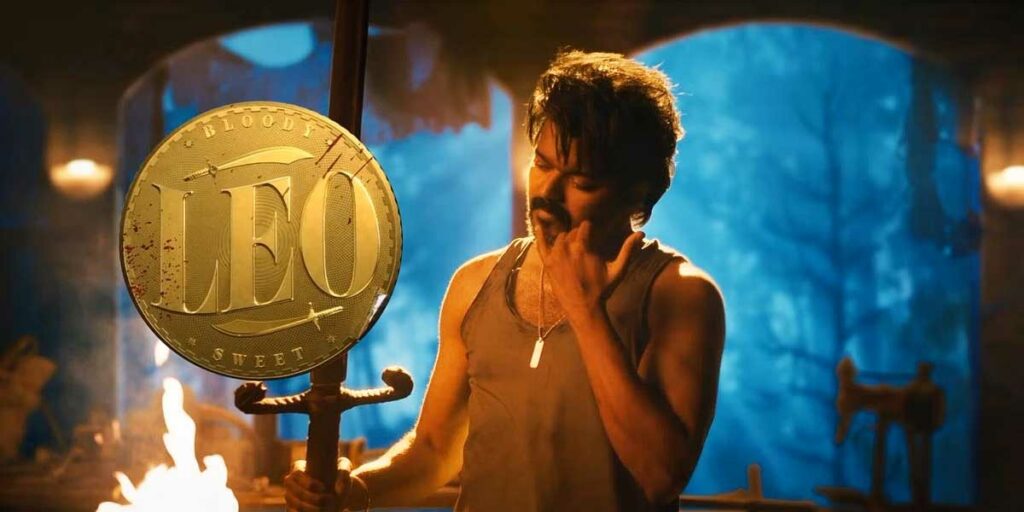Boosted by a career-best performance by Vijay and assured direction from Lokesh Kanagaraj, Leo quickly climbs to the top of the Lokesh Cinematic Universe as its best entry yet.
What happens when the flames of violence start to consume your body whole again after you’ve attempted to extinguish them for over twenty years? This question is central to Lokesh Kanagaraj’s Leo, the third installment in his highly lucrative Lokesh Cinematic Universe, which has now been released on Netflix after a [very] limited IMAX/PLF theatrical run in North America. The movie is inspired by David Cronenberg’s A History of Violence, and Lokesh’s central question is positioned through the mind of Parthiban (Vijay), an animal trapper/coffee shop owner who lives in the secluded state of Himachal Pradesh and begins to resort to extreme violence after his daughter (Iyal) is threatened by a group of gangsters who attempt to steal money from his coffee shop.
Something clicks inside of him, as visually represented through a dolly zoom, and we see him quickly kill these men without question in highly gruesome ways. Arrested and put on trial for murder, he is eventually acquitted based on self-defense and attempts to resume his everyday life with his wife (Trisha), son (Mathew Thomas), and daughter. However, the killings and trial were highly reported in the media, which catches the attention of Antony Das (Sanjay Dutt), a powerful drug dealer who believes he’s seen his son, Leo Das, who was allegedly killed over twenty years ago when Antony’s tobacco factory went down in flames.
Antony travels to Himachal Pradesh to talk to Parthiban, who unequivocally states he is not Leo despite the striking resemblance between the two. Believing he is lying, Antony kidnaps Parthiban’s son, with the flame of violence growing more potent inside of him. The most exciting part of Leo isn’t figuring out if Parthiban truly is Leo Das or not, but how Parthiban, a seemingly “ordinary man,” begins to snap as his family and peaceful life are threatened and slowly succumb to an irredeemable path filled with rage. The audience will eventually get an answer, but Lokesh focuses on something far more riveting during that scene that makes this 164-minute epic feel more psychologically alive than it has any right to be.
That’s partly due to a masterful performance from Thalapathy Vijay, perhaps even a career-best turn as Parthiban & Leo Das. I’ll admit to not being the biggest fan of his films (Beast is a disaster, and you can’t convince me otherwise), but after starring in Lokesh’s Master, he started to rise in my appreciation of Tamil stars. He doesn’t possess the same charm as Karthi, but something here makes his portrayal of the two characters work surprisingly well. That’s probably how Lokesh presents Parthiban: a resourceful but incredibly vulnerable man who longs for peace in Theog.
We continuously observe his vulnerability through Lokesh’s (and cinematographer Manoj Paramahamsa’s) camera – long tracking shots of Parthiban walking through the streets of Theog after a cold open that sees him fight a Hyena with his bare hands allow us to sit with him before his peace is threatened and begins to snap.

When he begins to resort to violence, the shift is clear, and the descent is equally as riveting to watch. It may not be as tight of a character study as Cronenberg’s film was. Still, Lokesh diverts his focus on other story elements that make his entire production feel alive through a singular directorial style he consistently refines from film to film. Vikram’s show-stopping interval scene saw Lokesh use a robocam to create movement as the titular protagonist’s plan is set in motion. Leo takes all of the stylistic flourishes Kanagaraj made in the past two LCU films. He dials it up to eleven, carrying the psychological transformation of Parthiban solely through its visual language and Vijay’s facial expressions.
There’s a frequent use of split-screen to exacerbate the tension and dread as Parthiban runs to save his family or a camera that grows more erratic as Parthiban’s mind naturally corrupts itself. What’s so special about Lokesh’s movies is how their style never stays the same as soon as it’s introduced: it consistently adapts to the situation and how the character evolves within the picture. Long crash zooms are frequent, but the eagle drone shots are among my favorites in the movie. The post-Naa Ready-bird’s eye view of Leo attempting to destroy Antony’s factory is a tracking shot captured entirely on a drone and gives the top-down gunfight from John Wick: Chapter 4 a run for its money.
As the movie reaches its ultraviolent climax, Kanagaraj’s style also becomes far more hyperkinetic and assuredly engaging, with enough mind-melting action to give you the biggest adrenaline rush of your life. The highway car chase may over-rely too much on outlandish CGI. Still, I’d be lying if I wasn’t slapping my seat and hooting and hollering while Parthiban and Napoleon (George Maryan, reprising his role from Kaithi) attempt to take out Antony’s motorcade with a gun. But the action is also surprisingly more brutal than you think, with the Netflix version blurring out a few parts that are too violent for American censors. However, all of these moments help enhance the emotional stakes on screen and the core character study on how the flames of violence can never be truly extinguished from a person who was born and raised out of violence.
If all you’ve known in your life was terror and violence, even in your best attempts to suppress your innate nature, the flames will come crawling back and consume you in more powerful ways than they initially did. In that regard, Lokesh and Vijay more than succeed in reinterpreting A History of Violence to this decade with a greater sense of style and scope than Cronenberg did in 2005. It also helps that Vijay gives the best performance of his career, as we see the literal and figurative beast awaken inside Parthiban. One hopes he never puts it back in his metaphorical cage.
Leo is now available to watch on Netflix in India and globally.

